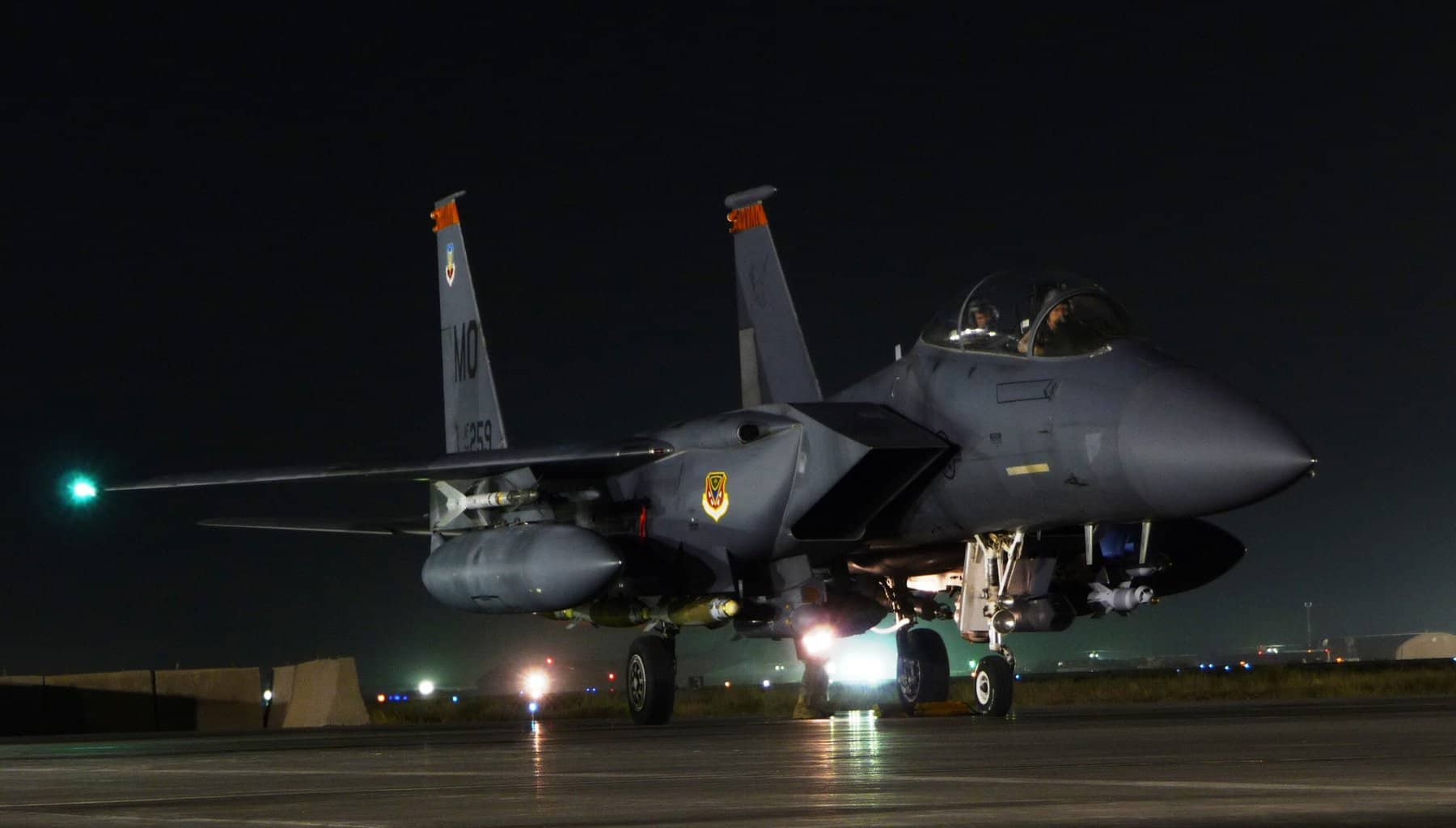
PEAK PERFORMANCE: Fighter Pilot Lessons for Elite Levels of Performance in Your Daily Life.
8.5 minute read
Crossing the push point at 15,000 feet in a 2+2 formation, I look to my left and see my flight lead a mile and a half just above the horizon. I start to check my systems one more time. Master Arm hot. Air-to-Air master mode. Fuel, checks. Engine and hydraulics good. I look forward through my heads-up display. Flight path marker on the horizon, steering set to the next point, airspeed and altitude as briefed. The UHF radio cracks in my helmet and I hear, “Jangle, take it down”.
I look left just in time to see Flight Lead roll inverted and pull towards the earth in a 30-degree nose-low dive. I roll quickly to match his descent and remain in formation, one of my chief objectives as a wingman. I look left to regain visual. Where’d he go? I quickly realize we are inverted, he’s on the right now. Shift my lookout and check right. I pick him up just below the horizon, shallowing his descent. Visual.
Peak performance beings with preparation. Fighter pilots train to perfect multiple mission sets every day. When the klaxon goes off and jets are scrambled, the fighter pilot must be ready for anything from close escort of a strike package to defensive counter air to protect a target to close air support for a ground commander seizing an objective. To reach peak performance, begin by getting your mind, body and soul prepared for anything life may throw at you.
I roll upright and gain the visual again on my left, snap my eyes back to my HUD and start to execute the standard dive recovery rules so I don’t drive my perfectly good jet into the dirt. 30 degrees. 20. 10 degrees, shallow out and pick up 500 feet above ground level. Lead is at 300 feet making the visual more difficult. Add to that the terrain and mountains of southern Idaho and it’s next to impossible to see him all the time. Look for the shadow of his jet over the trees. Remain predictable, fly the briefed route, altitude, airspeed and formation.
Focus. Looking forward I check my flight path marker above the next rise in the terrain, airspeed is set to 480 ground speed, 8 miles per minute. Ok, relax and get into my cross-check rhythm. Visual on Lead, flight path marker above the horizon, airspeed, altitude, visual. Flight path marker, speed 500, throttle back slightly to capture 480 ground speed, fuel flow, warning systems, visual, flightpath marker. This cross-check goes on for over 100 miles through valleys, over mountain peaks, draws, riverbeds, canyons, and plains. Don’t hit the ground or anything attached to the ground, stay visual, and don’t run out of gas.
Peak performance requires a solid understanding of the fundamentals, and the ability to fall back on knowledge and training gained over many hours of preparation. To execute anything at a high level, skills must be honed razor sharp, and processes must be simplified to a point you can remember and execute the steps without thinking. Do ordinary things extraordinarily well by keeping things simple, rote, and repeatable.
Checking timing, fuel and weapons is routine as well. This is a dangerously fun and busy sortie; the kind of flight you get out of the cockpit sweaty. But the low-level interdiction is the easy part. Be unseen, unheard, and hit the target before the enemy knows you’re there. That’s the hard part.
Visual, flight path marker, weapons check, visu…where the hell is LEAD? He should be right the….there he is. Visual. Flight path marker. 30 seconds to the Initial Point. Set Air-to-Ground master mode. Push the throttles up, set 540 ground speed. Laser armed. Code set and matched. Weapons powered up. Target designated. 10 seconds to the pull point. Visual. Flight path marker. Airspeed 550. There’s the cue. Pull up 2 Gs, 3 Gs, 4 Gs. Follow the steering line.
As I pass 1000 feet above ground level, I look outside and find the target with my eyes. “2’s Tally target”. Follow the steering line, set 30 degrees nose-high attitude, and wait for the cue. 3…2…1 release. Ka-thunck. The 2000-pound, laser-guided bomb releases from my jet. I snap the stick hard to the right and set 135 degrees roll over to get back to wings level to minimize my time above the enemy radar scan. When I roll out and look left and see the bomb flying towards the target.
Peak performance is reached when you can filter out all the noise around the task at hand, focus on what matters and what you can control, and execute in spite of distractions and dangers. Getting into the flow state, otherwise known as the zone, is the state of mind where everything outside the target gets muted, and your focus is as tight as looking through a soda straw. Nothing can break your concentration and determination to succeed.
Pull up the infrared targeting pod, latch the target, and fire the laser. 25 seconds to impact. Visual is over my left shoulder at about 8 o’clock, level. Everything is working as briefed. 10 seconds to impact. All of a sudden, lights and sounds erupt in my cockpit and helmet. A quick glance reveals I am being targeted by the Surface to Air Missile (SAM) system guarding the target. We knew about it and discussed in the brief what to do if we were engaged. 3 seconds to impact. 2. 1. My targeting pod washes out white. I can’t see the target anymore as the bomb’s impact and the thermal bloom from the heat of the explosion render my system useless for a few seconds.
As the heat dissipates slightly, I can clearly see the target is destroyed, and I immediately roll right, over-rotate the jet to begin my threat reaction from the SAM and begin my egress of the threat area. Lights still flashing and warning in my headset, I dive for the nape of the earth. Ahead is a small ridge. If I can get to that ridge and duck over the other side, I might just make it. I turn left, then right, flight path marker, warning system, put the threat over my left shoulder, expend countermeasures, don’t hit the ground, push the throttles up. I skim the ridge and roll over to the other side as the warnings subside and silence.
Peak performance means understanding what matters most in an instant, deliberately controlling your actions with intention and prioritization, and being decisive at the exact moment of influence to achieve the desired outcome of the task. Waffling over a decision until you “feel ready” or have “enough information” will delay your actions and can lead to failure. Peak performers move the jet when they need to, how they need to, in response to the stimuli given in that instant, and make adjustments after the fact.
This isn’t over yet. My threat reaction has taken my fuel level below “bingo”, the briefed amount required to continue on the planned profile. I pull the throttles back and set cruise speed, still at 500 feet. Where is Lead? “2’s blind, 500 feet.” “Jangle 1 is your right 4 o’clock, level.” I snap my neck right and scan. Visual! “2’s visual, bingo, attack successful”. The cross-check begins all over again but with an added level of emphasis on fuels. Passing the original push point, we begin a climb back to 20,000 feet and set max-range speeds to home base.
This entire event lasted around 35 minutes. Most people will not have that much activity in an entire week or month. Flying fighter jets gets crew members used to making split-second decisions based on knowledge and preparation, a good plan, and paying attention in the flight briefing. Even with all that, sometimes you have to just be decisive, call an audible, and operate on instinct. Get away from the threat. Fly the correct profile. There is no reverse in fighter jets, and do-overs rarely exist.
The only way to reach this level of performance and execution is to consistently put yourself in pressure situations. Test yourself. Challenge yourself. Never sit idle. Always be improving your mind-body-soul balance. If you are not growing, you’re dying. Obviously, only a small percentage of people get this level of exposure to risk, high speeds, adrenaline and threats. But you can condition yourself to be more aware of and prepared for your surroundings, pay attention to subtle details of everyday life, be on heightened alert to daily threats, and consistently push yourself to do more and be a better version of yourself.
Improve. Ignite. Inspire.
